- Thread starter
- #1,281
Navigation
Install the app
How to install the app on iOS
How To Use Progressive Web App aka PWA On 420 Magazine Forum
Note: This feature may not be available in some browsers.
More options
You are using an out of date browser. It may not display this or other websites correctly.
You should upgrade or use an alternative browser.
You should upgrade or use an alternative browser.
Graytail's Cupwinners in High Brix Soil - 4x4 - 600W HPS - Perpetual
Dennise
Well-Known Member

Conradino23
Well-Known Member
Hmm I really need to get a refractometer  Just to check what's in my weed... and tomatoes, red peppers, zucchini, potatoes and the rest of bunch
Just to check what's in my weed... and tomatoes, red peppers, zucchini, potatoes and the rest of bunch  Basically, after amending my soil heavily I got very big crop of tomatoes, which were as sweet as Sicilian ones and my sauce needed little balancing with spices... hmm, this year I started adding crushed lava rock
Basically, after amending my soil heavily I got very big crop of tomatoes, which were as sweet as Sicilian ones and my sauce needed little balancing with spices... hmm, this year I started adding crushed lava rock  My tomatoes have very thick stems, leaves are deep green, vigorus kind of color, and they're branching out like crazy, effect of stinging nettle + comfrey + horsetail + compost teas
My tomatoes have very thick stems, leaves are deep green, vigorus kind of color, and they're branching out like crazy, effect of stinging nettle + comfrey + horsetail + compost teas 
What is cat drench?
 Just to check what's in my weed... and tomatoes, red peppers, zucchini, potatoes and the rest of bunch
Just to check what's in my weed... and tomatoes, red peppers, zucchini, potatoes and the rest of bunch  Basically, after amending my soil heavily I got very big crop of tomatoes, which were as sweet as Sicilian ones and my sauce needed little balancing with spices... hmm, this year I started adding crushed lava rock
Basically, after amending my soil heavily I got very big crop of tomatoes, which were as sweet as Sicilian ones and my sauce needed little balancing with spices... hmm, this year I started adding crushed lava rock  My tomatoes have very thick stems, leaves are deep green, vigorus kind of color, and they're branching out like crazy, effect of stinging nettle + comfrey + horsetail + compost teas
My tomatoes have very thick stems, leaves are deep green, vigorus kind of color, and they're branching out like crazy, effect of stinging nettle + comfrey + horsetail + compost teas 
What is cat drench?
Hmm I really need to get a refractometerJust to check what's in my weed... and tomatoes, red peppers, zucchini, potatoes and the rest of bunch
Basically, after amending my soil heavily I got very big crop of tomatoes, which were as sweet as Sicilian ones and my sauce needed little balancing with spices... hmm, this year I started adding crushed lava rock
My tomatoes have very thick stems, leaves are deep green, vigorus kind of color, and they're branching out like crazy, effect of stinging nettle + comfrey + horsetail + compost teas
What is cat drench?
Lava Rock=minerals. Minerals, including and especially calcium, is what increases sugar and nutritional content in fruit.
Cat Drench is short for Cationic Root Drench. We use it to change the ionic balance of the soil to favor reproductive growth, especially seed production.
- Thread starter
- #1,285
There's been misunderstanding because of the way high brix growing methods were introduced to 420Mag, by Doc in his early experimentation and later with his kit. Any well-designed organic soil will measure "high brix", in the 10-14 range. The trick is in designing the soil. Almost no one begins with a soil test. Almost no one actually knows why one mix works better than another. Icemud does fabulous work with his mixes, but I doubt he really knows what's happening in the soil - they just work well for him. BigIrishDoode cooks up some amazingly nutritious mineralized coco mixes. There are Super Soils. I would imagine any of these measure high brix, and that's a good thing.
But most of us also know about far more growers who mix some of this and some of that, and maybe it goes well, maybe it doesn't. We layer soils, we spike soils, we flush soils and drench soils. We add organic this and some organic that, we brew various teas, and maybe it goes well, maybe it doesn't. If we stick to the nute schedule, we get some pretty good smoke. If you read Doc's earlier journals, you'll see that he was looking for some method that worked simply and simply worked. Osmocote Plus was a great example. If you want to avoid screwing up your grow and have no desire to fiddle with measuring nutes and timing, just put some time-release OC+ in FFOF and jus' water 'em. I guarantee you'll turn out weed every bit as good as the guys who ride the edge of nute burn and lockouts.
Doc Bud's High Brix Kit is simply a foolproof way to grow very high brix cannabis without testing your soil and having the perfect mix designed for it - that's been done by Doc. You don't have to buy quarts of stuff and figure out how to use it - Doc did that already. You don't have to wonder how it will turn out because the rest of us have tried it and can tell you that it's really really hard to screw up.
So if you're intrigued by high brix methods and it all seems a little odd to you, read BID's journals and Icemud's journals, both of whom measure for brix and have tried Doc's kit. They prefer to mix their own soils but the goal is the same. We're all hooked on the expanded terpene profiles and the sometimes shocking potency, not to mention the almost nonexistant feeling of having inhaled smoke - smooooooth. Doc's kit will get you there, the path is laid out. It's even evolving as we discover the correct mineral ratios for cannabis specifically.
I don't mean to sound like some kind of evangelist, I apologize. I just don't want to try to figure out exactly how to amend a soil to produce a high brix environment. I could - all the information is available - I just don't want to. But after becoming quite intimate with the produce from Doc's kit, I wouldn't want to try to grow any other way. So I recommend Doc Bud's High Brix Kit without reservation, and I encourage everyone to try to grow high brix cannabis.
It's better stuff.
But most of us also know about far more growers who mix some of this and some of that, and maybe it goes well, maybe it doesn't. We layer soils, we spike soils, we flush soils and drench soils. We add organic this and some organic that, we brew various teas, and maybe it goes well, maybe it doesn't. If we stick to the nute schedule, we get some pretty good smoke. If you read Doc's earlier journals, you'll see that he was looking for some method that worked simply and simply worked. Osmocote Plus was a great example. If you want to avoid screwing up your grow and have no desire to fiddle with measuring nutes and timing, just put some time-release OC+ in FFOF and jus' water 'em. I guarantee you'll turn out weed every bit as good as the guys who ride the edge of nute burn and lockouts.
Doc Bud's High Brix Kit is simply a foolproof way to grow very high brix cannabis without testing your soil and having the perfect mix designed for it - that's been done by Doc. You don't have to buy quarts of stuff and figure out how to use it - Doc did that already. You don't have to wonder how it will turn out because the rest of us have tried it and can tell you that it's really really hard to screw up.

So if you're intrigued by high brix methods and it all seems a little odd to you, read BID's journals and Icemud's journals, both of whom measure for brix and have tried Doc's kit. They prefer to mix their own soils but the goal is the same. We're all hooked on the expanded terpene profiles and the sometimes shocking potency, not to mention the almost nonexistant feeling of having inhaled smoke - smooooooth. Doc's kit will get you there, the path is laid out. It's even evolving as we discover the correct mineral ratios for cannabis specifically.
I don't mean to sound like some kind of evangelist, I apologize. I just don't want to try to figure out exactly how to amend a soil to produce a high brix environment. I could - all the information is available - I just don't want to. But after becoming quite intimate with the produce from Doc's kit, I wouldn't want to try to grow any other way. So I recommend Doc Bud's High Brix Kit without reservation, and I encourage everyone to try to grow high brix cannabis.
It's better stuff.

thanks Graytail!There's been misunderstanding because of the way high brix growing methods were introduced to 420Mag, by Doc in his early experimentation and later with his kit. Any well-designed organic soil will measure "high brix", in the 10-14 range. The trick is in designing the soil. Almost no one begins with a soil test. Almost no one actually knows why one mix works better than another. Icemud does fabulous work with his mixes, but I doubt he really knows what's happening in the soil - they just work well for him. BigIrishDoode cooks up some amazingly nutritious mineralized coco mixes. There are Super Soils. I would imagine any of these measure high brix, and that's a good thing.
But most of us also know about far more growers who mix some of this and some of that, and maybe it goes well, maybe it doesn't. We layer soils, we spike soils, we flush soils and drench soils. We add organic this and some organic that, we brew various teas, and maybe it goes well, maybe it doesn't. If we stick to the nute schedule, we get some pretty good smoke. If you read Doc's earlier journals, you'll see that he was looking for some method that worked simply and simply worked. Osmocote Plus was a great example. If you want to avoid screwing up your grow and have no desire to fiddle with measuring nutes and timing, just put some time-release OC+ in FFOF and jus' water 'em. I guarantee you'll turn out weed every bit as good as the guys who ride the edge of nute burn and lockouts.
Doc Bud's High Brix Kit is simply a foolproof way to grow very high brix cannabis without testing your soil and having the perfect mix designed for it - that's been done by Doc. You don't have to buy quarts of stuff and figure out how to use it - Doc did that already. You don't have to wonder how it will turn out because the rest of us have tried it and can tell you that it's really really hard to screw up.
So if you're intrigued by high brix methods and it all seems a little odd to you, read BID's journals and Icemud's journals, both of whom measure for brix and have tried Doc's kit. They prefer to mix their own soils but the goal is the same. We're all hooked on the expanded terpene profiles and the sometimes shocking potency, not to mention the almost nonexistant feeling of having inhaled smoke - smooooooth. Doc's kit will get you there, the path is laid out. It's even evolving as we discover the correct mineral ratios for cannabis specifically.
I don't mean to sound like some kind of evangelist, I apologize. I just don't want to try to figure out exactly how to amend a soil to produce a high brix environment. I could - all the information is available - I just don't want to. But after becoming quite intimate with the produce from Doc's kit, I wouldn't want to try to grow any other way. So I recommend Doc Bud's High Brix Kit without reservation, and I encourage everyone to try to grow high brix cannabis.
It's better stuff.
However, for the record, neither BID or Icemud have used my kit.
My mineralized soil grows were never much higher than 12 brix at best. The first grow with the proper soil was a real eye-opener.
My kit produces optimum high brix soil. I suggest people try it out a few times and then maybe try a tea or something in order to "personalize" their produce. The kit is designed for the future, when people will be growing 10,000 sq ft at a time and need consistent quality run after run, with products that are compatible with fertigation, foggers, sprayers etc.
The kit itself is like a professional sample. Try it for a reasonable price and if you like it we can set you up with bulk orders, etc. Also, I update things regularly with new information, results from trial and error, etc.
- Thread starter
- #1,287
However, for the record, neither BID or Icemud have used my kit.
Oops!
I've never tried the kit... I was going to back in October but had some soil and amendments on hand and made my own mix. I got lucky with it. The last two harvests have been 16 and 17.5 brix when I squeezed fan leaves. One thing I've noticed is that the brix has increased in both cases from ~ 14 to the higher numbers in the last week or ten days as I've cut off water and the plants have lost moisture in preparation for harvest. I'm assuming that happens because as the moisture is less available in the soil, and water continues to transpire through the leaves - the fluid inside the plant becomes more concentrated. The higher concentration of dissolved solids results in a higher brix reading.
One thing I wonder about is if the very dry environment here (single digit RH is common) increases the brix. Low RH leads to increased transpiration thus concentrating the fluid matrix the plant pulls from the soil.
Perhaps this fall I'll get a kit and do a side by side with my own mix. I expect that the kit will do better purely because more attention has been paid to the mineral balance. Most of the minerals compete for transporters in plants as well as animals. For example, if a human consumes too much calcium it can lead to a phosphorous or magnesium deficiency since all three minerals largely depend on the same transport protein...
The quality of product produced by the kit speaks for itself. I frequently recommend it to folks even though I've never actually used it!
One thing I wonder about is if the very dry environment here (single digit RH is common) increases the brix. Low RH leads to increased transpiration thus concentrating the fluid matrix the plant pulls from the soil.
Perhaps this fall I'll get a kit and do a side by side with my own mix. I expect that the kit will do better purely because more attention has been paid to the mineral balance. Most of the minerals compete for transporters in plants as well as animals. For example, if a human consumes too much calcium it can lead to a phosphorous or magnesium deficiency since all three minerals largely depend on the same transport protein...
The quality of product produced by the kit speaks for itself. I frequently recommend it to folks even though I've never actually used it!
I've never tried the kit... I was going to back in October but had some soil and amendments on hand and made my own mix. I got lucky with it. The last two harvests have been 16 and 17.5 brix when I squeezed fan leaves. One thing I've noticed is that the brix has increased in both cases from ~ 14 to the higher numbers in the last week or ten days as I've cut off water and the plants have lost moisture in preparation for harvest. I'm assuming that happens because as the moisture is less available in the soil, and water continues to transpire through the leaves - the fluid inside the plant becomes more concentrated. The higher concentration of dissolved solids results in a higher brix reading.
One thing I wonder about is if the very dry environment here (single digit RH is common) increases the brix. Low RH leads to increased transpiration thus concentrating the fluid matrix the plant pulls from the soil.
Perhaps this fall I'll get a kit and do a side by side with my own mix. I expect that the kit will do better purely because more attention has been paid to the mineral balance. Most of the minerals compete for transporters in plants as well as animals. For example, if a human consumes too much calcium it can lead to a phosphorous or magnesium deficiency since all three minerals largely depend on the same transport protein...
The quality of product produced by the kit speaks for itself. I frequently recommend it to folks even though I've never actually used it!
Testing fan leaves is somewhat problematic during the bloom cycle as they are often dehydrated and/or suffering nutrient burn, depending on circumstances.
I recommend taking healthy, vibrant leaves during pruning for a more accurate reading. But regardless of methodology, as long as you do the testing the same way each and every time, you'll get a measurement that is useful for YOUR situation, but not transferable to others who use different testing methods.
I've tested stuff I trimmed off the plant the day before and gotten reading in the high 20's.....because it was almost crispy. I've also tested nute-burned leaves and gotten in the high 20's. Testing healthy tissue on the same plants I tested crispy tissue resulted in readings below 12.....
But my highest "correct" readings ever were flirting with 18 and that was from healthy meristematic tissue, with the uppermost fan leaf and petiole. That's what I test now....clip the tops off just below the first fan leaf and crush it all up.
Those who test similar to me usually get reading similar to mine.
Knowing what I know about achieving high brix it is nearly impossible to get there with a guessed at soil mix. Adding the minerals will improve ANY organic grow and raise brix, but it's not the same as getting it right via soil testing and customized broadcast. Mostly, it's potassium and sodium that causes trouble in DIY mixes.
I "invented" the 6-5-3 mineral addition and I couldn't get my plants "in the zone" with that mix, although it was an order of magnitude better than supersoil and produced what I thought was killer weed at the time.
Those who have done both will attest to what I'm saying.
PUrple Cadillac: Week 5. Brix 14-15 and rising.

The harvest brix readings have been taken from wads of small fan leaves stripped at harvest. They have not been "old growth." It took some practice and experimentation to get what I considered good samples. I too have noticed that older more desiccated fan leaves produce a higher reading. It has been fun to explore brix fluctuations relative to where on the plant the "squeezings" come from, and how they change relative to when the plant was last watered, etc. A refractometer is a fun toy but getting a good sample takes some trial and error. I endeavor to get a drop or two from crushed plant material suspended above the prism surface without the plant material ever making contact with the glass surface.
Frankly, Doc, I'm somewhat surprised by the brix readings I've been getting. My skeptical nature leads me to wonder about things like the effect of soil moisture and RH on brix. You frequently refer to viniculturalists in brix discussions. Typically grape growers love a dry fall with lower soil moisture and RH which leads to a higher concentration of terpines in the stems, seeds and skins of the berries, as well as a higher sugar concentration (or more specifically higher sugar/organic acid ratios) in the fleshy interior i.e.; higher brix and lower overall weight yields. In theory high brix readings come from a combination of soil and atmospheric conditions. I will definitely get around to comparing kit soil with my own mix, and as I said before, I expect to see higher readings and an increase in quality in kit soil.
Here is a picture of some Darkstar at five weeks. Brix was about 14 and it harvested at 17.5. I'm growing some good quality smoke.

Frankly, Doc, I'm somewhat surprised by the brix readings I've been getting. My skeptical nature leads me to wonder about things like the effect of soil moisture and RH on brix. You frequently refer to viniculturalists in brix discussions. Typically grape growers love a dry fall with lower soil moisture and RH which leads to a higher concentration of terpines in the stems, seeds and skins of the berries, as well as a higher sugar concentration (or more specifically higher sugar/organic acid ratios) in the fleshy interior i.e.; higher brix and lower overall weight yields. In theory high brix readings come from a combination of soil and atmospheric conditions. I will definitely get around to comparing kit soil with my own mix, and as I said before, I expect to see higher readings and an increase in quality in kit soil.
Here is a picture of some Darkstar at five weeks. Brix was about 14 and it harvested at 17.5. I'm growing some good quality smoke.

The harvest brix readings have been taken from wads of small fan leaves stripped at harvest. They have not been "old growth." It took some practice and experimentation to get what I considered good samples. I too have noticed that older more desiccated fan leaves produce a higher reading. It has been fun to explore brix fluctuations relative to where on the plant the "squeezings" come from, and how they change relative to when the plant was last watered, etc. A refractometer is a fun toy but getting a good sample takes some trial and error. I endeavor to get a drop or two from crushed plant material suspended above the prism surface without the plant material ever making contact with the glass surface.
Frankly, Doc, I'm somewhat surprised by the brix readings I've been getting. My skeptical nature leads me to wonder about things like the effect of soil moisture and RH on brix. You frequently refer to viniculturalists in brix discussions. Typically grape growers love a dry fall with lower soil moisture and RH which leads to a higher concentration of terpines in the stems, seeds and skins of the berries, as well as a higher sugar concentration (or more specifically higher sugar/organic acid ratios) in the fleshy interior i.e.; higher brix and lower overall weight yields. In theory high brix readings come from a combination of soil and atmospheric conditions. I will definitely get around to comparing kit soil with my own mix, and as I said before, I expect to see higher readings and an increase in quality in kit soil.
Here is a picture of some Darkstar at five weeks. Brix was about 14 and it harvested at 17.5. I'm growing some good quality smoke.

You sure are bro!
As long as you're sampling the same way each time, the readings are a great tool. However, readings in the 20's are not in range.
As far as higher readings in kit soil.....only if kit soil is better than your soil. While it's a crap shoot to get it right by guessing, it certainly is in the realm of possibilities. Your produce is certainly convincing!
- Thread starter
- #1,292
As long as we're on this whole brix testing subject ...
Yesterday I decided to take some pics while I tested Carn2. Here's what I start with - vicegrips, a couple of thick metal slugs, a refractometer, and a typical healthy 5 bladed leaf.
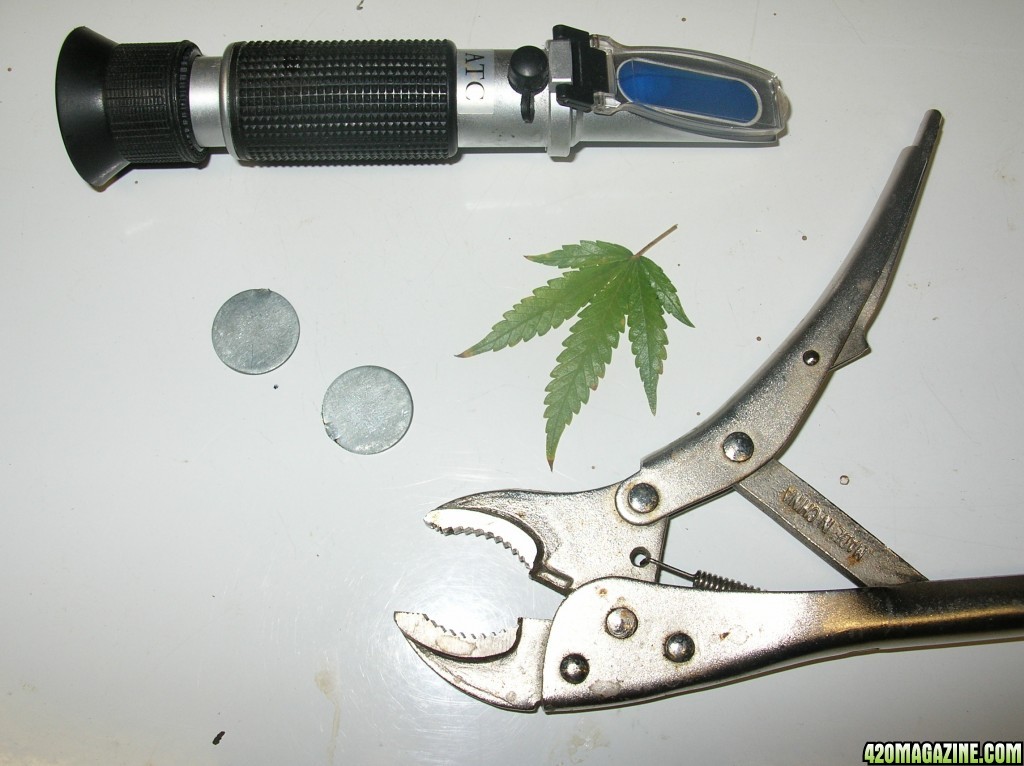
I start by tucking the pertiole against the leaf and rolling/twisting it together.
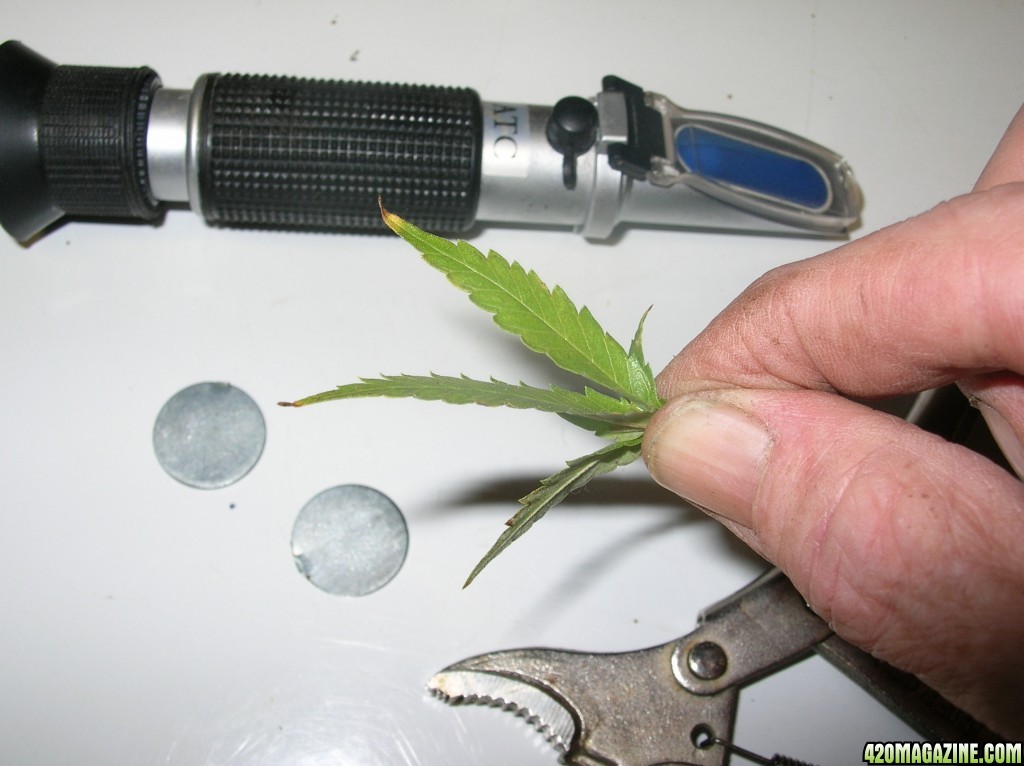
Tuck it again, twist some more ...
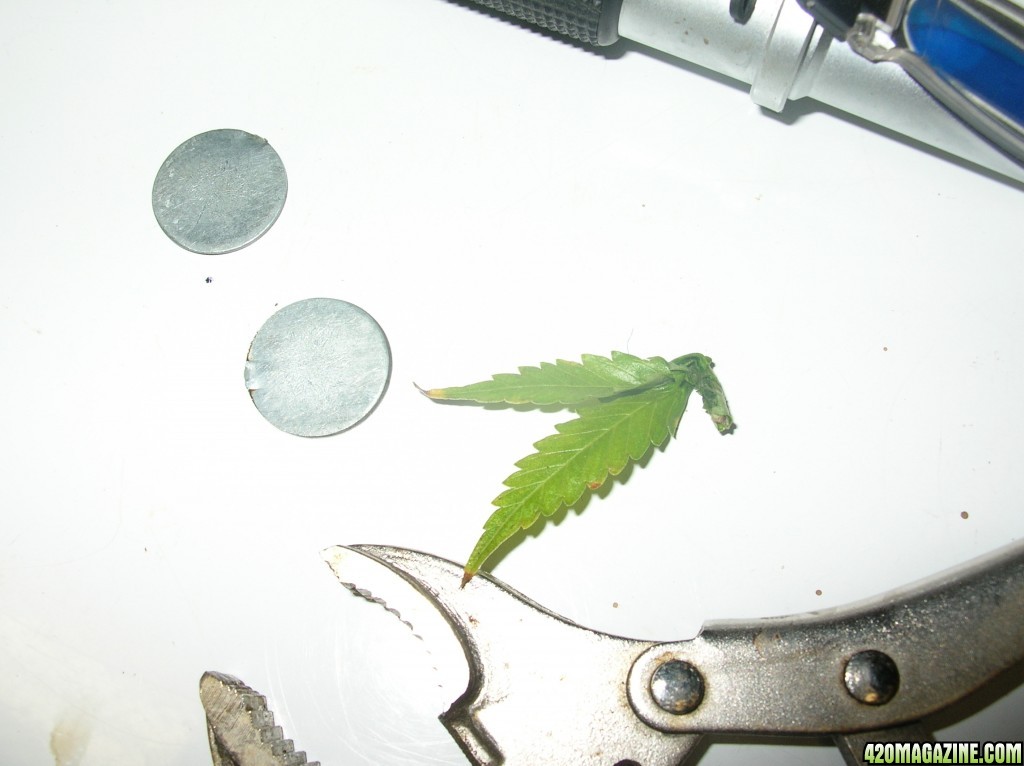
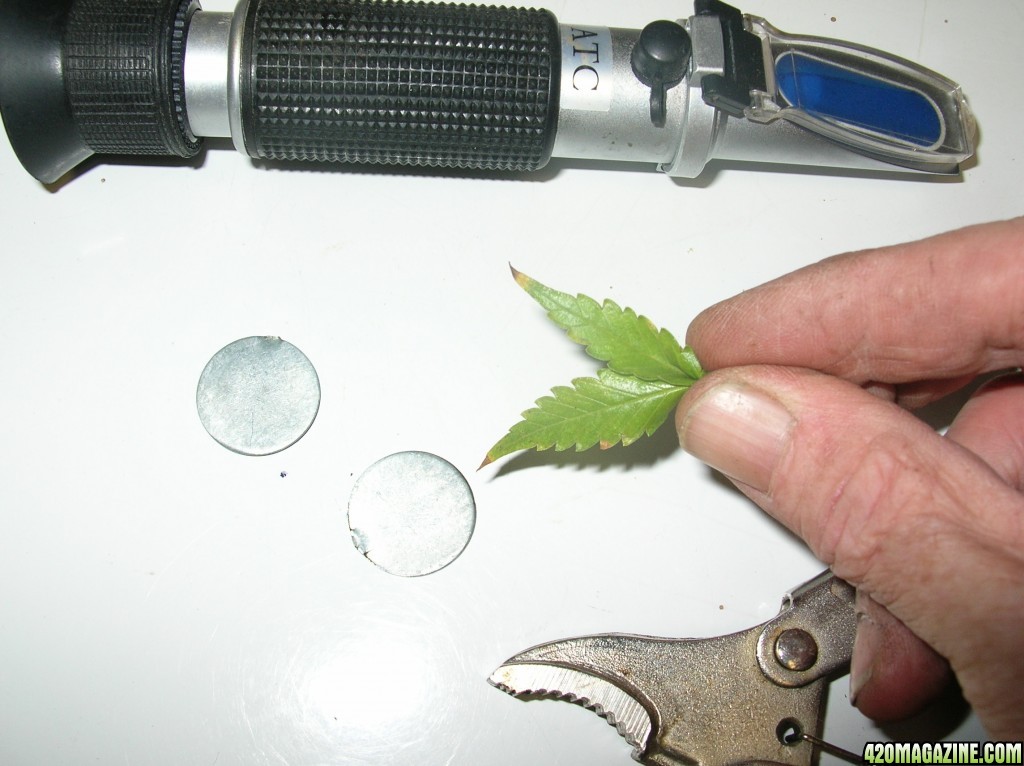
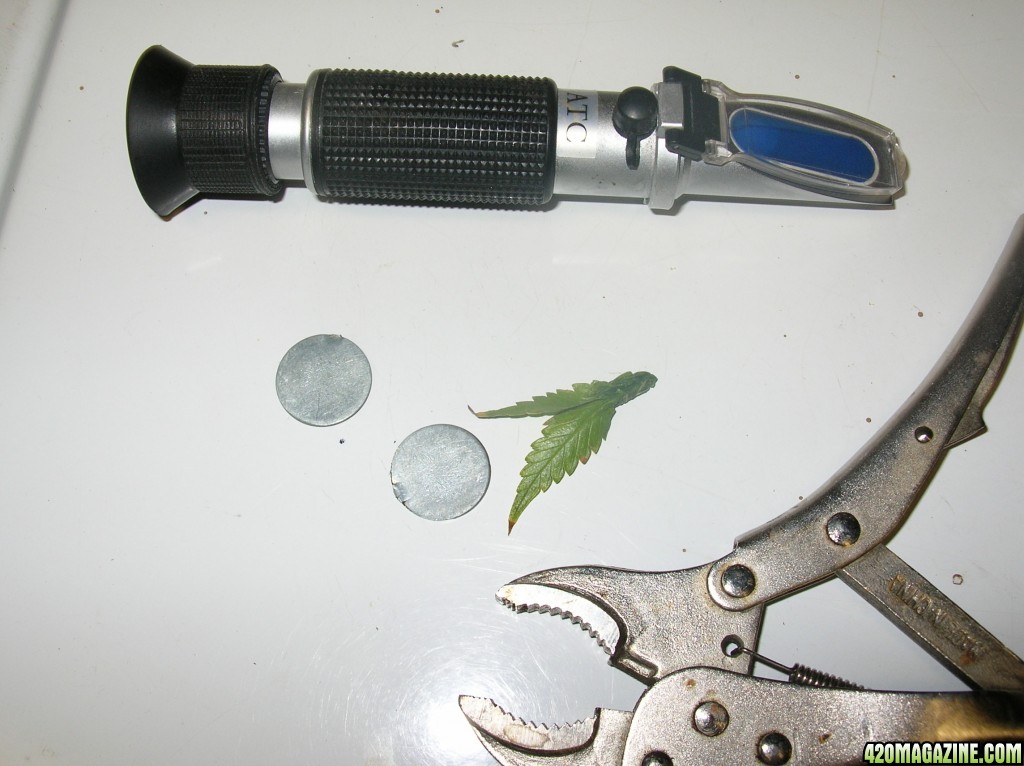
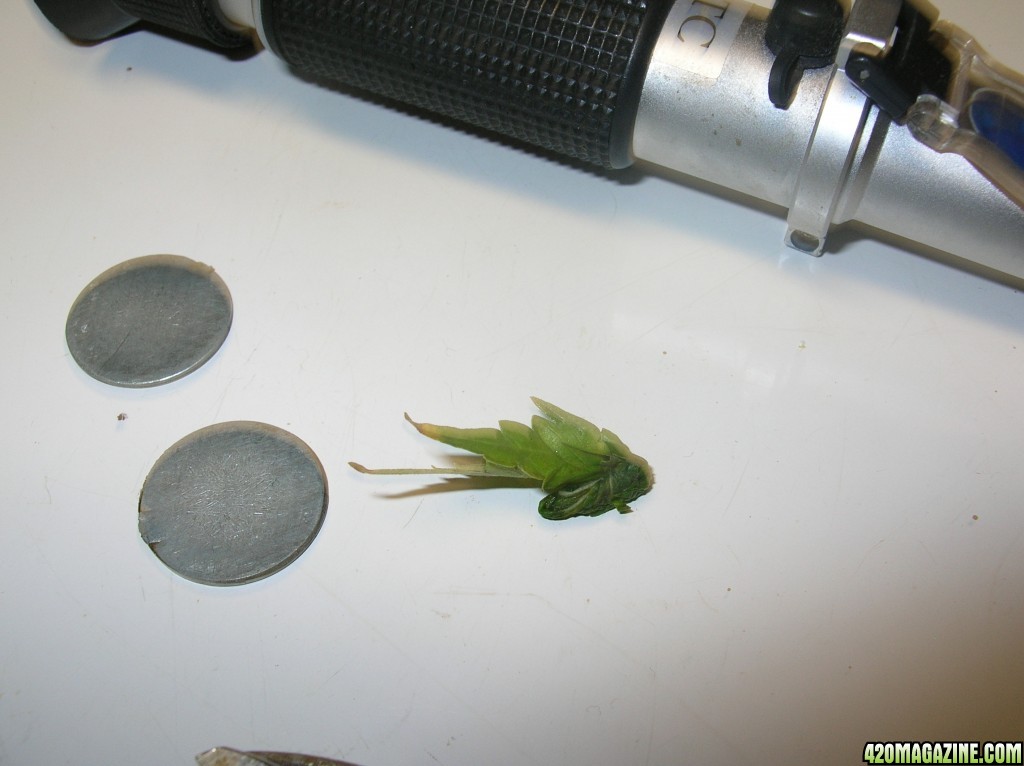
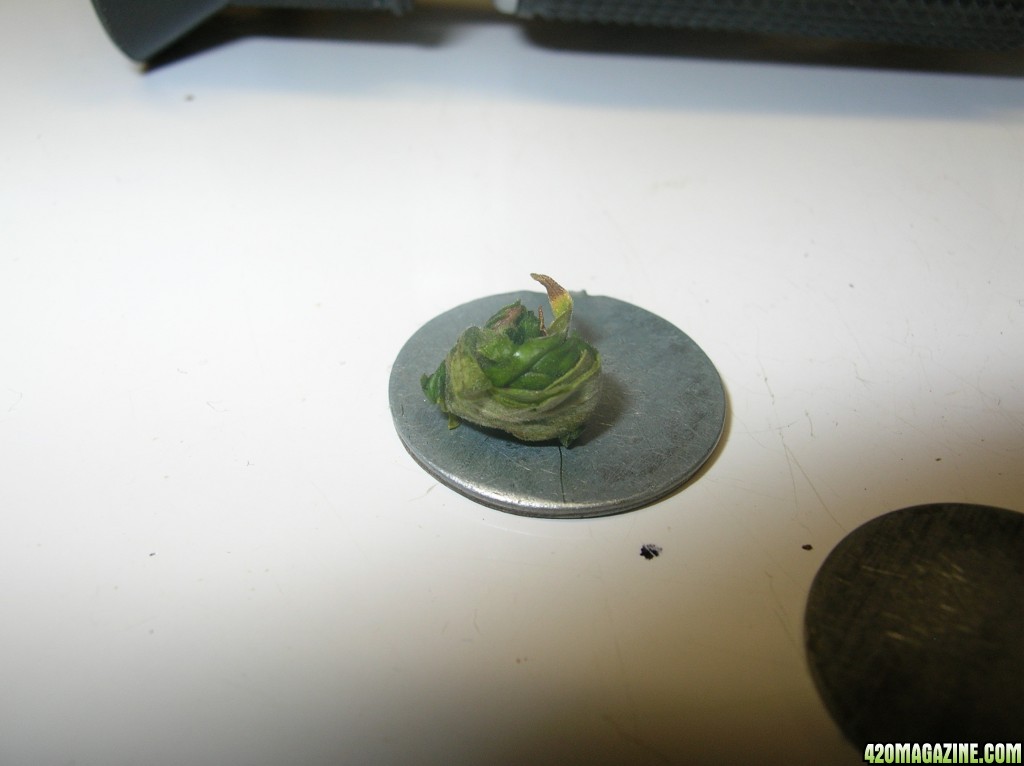
I put the wad between the slugs and squish it carefully around the disks without releasing any juice ...
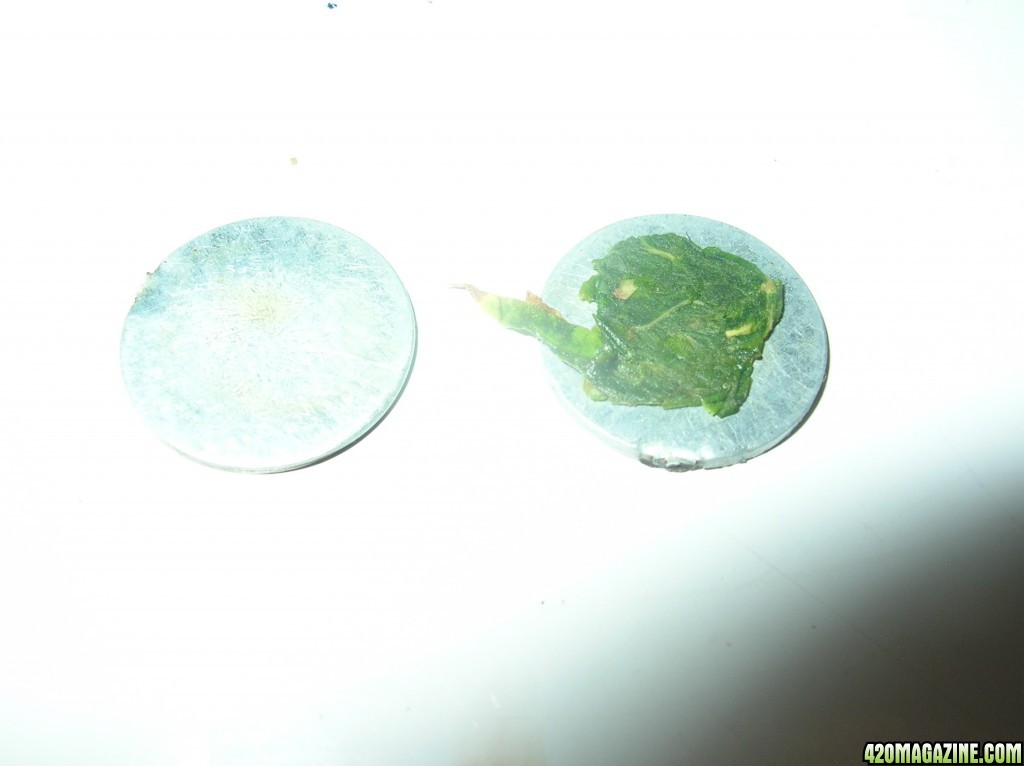
I reroll it, squish it for real and let a drop touch the prism ...
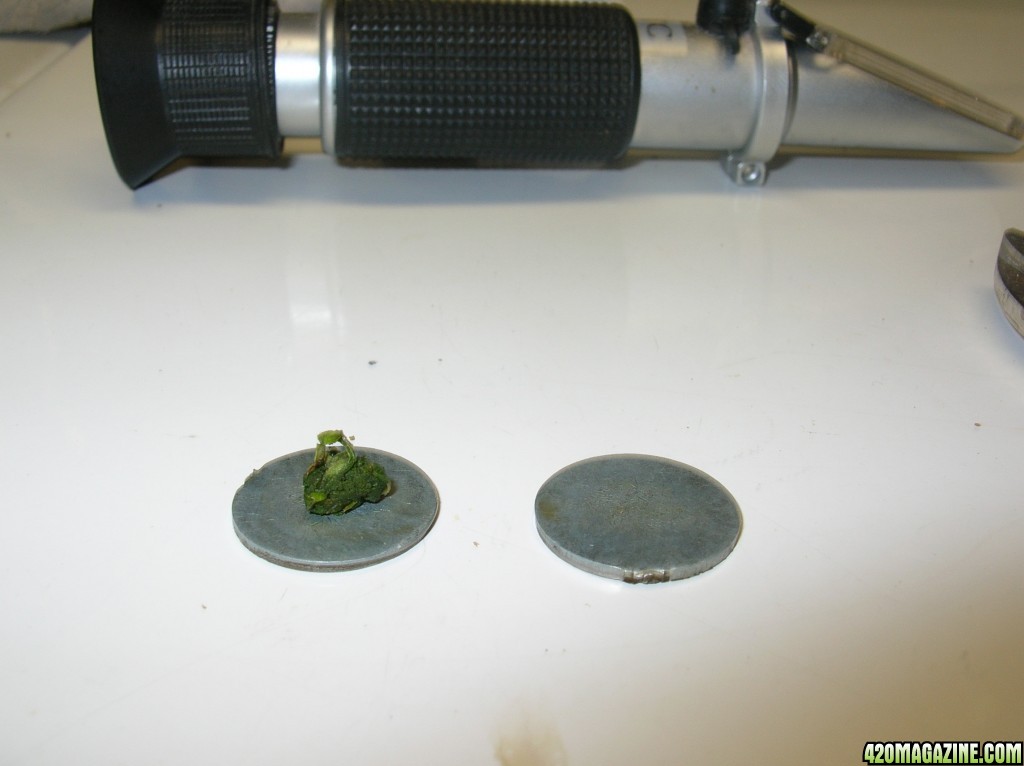
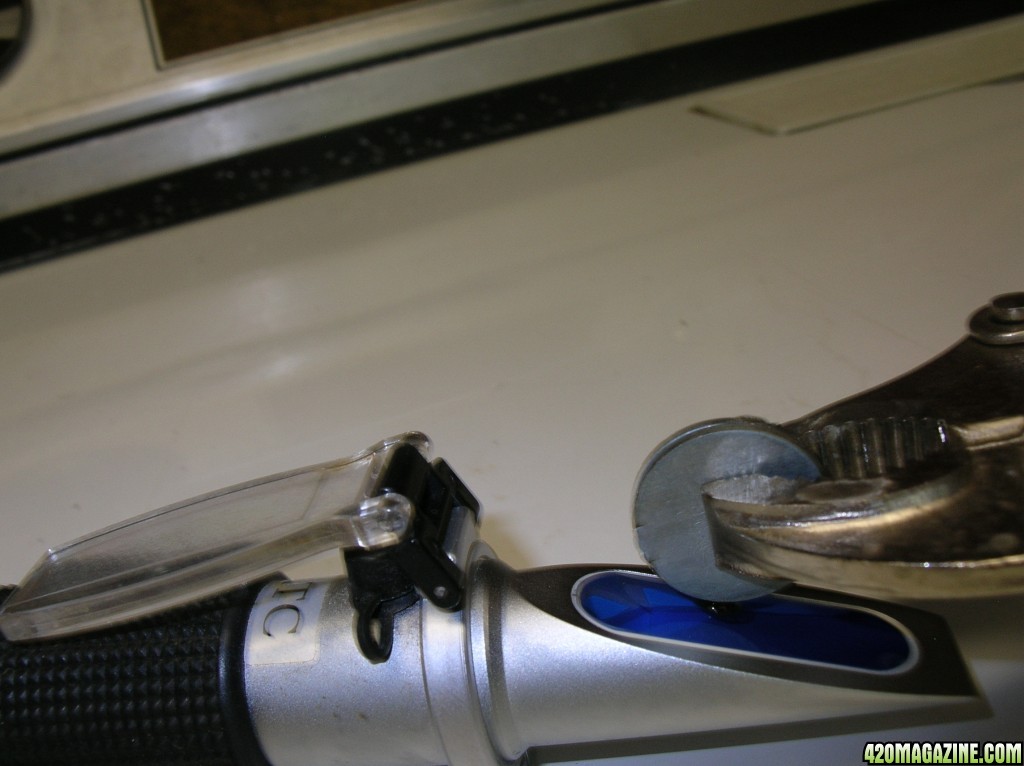
Flip it closed and take a reading ...
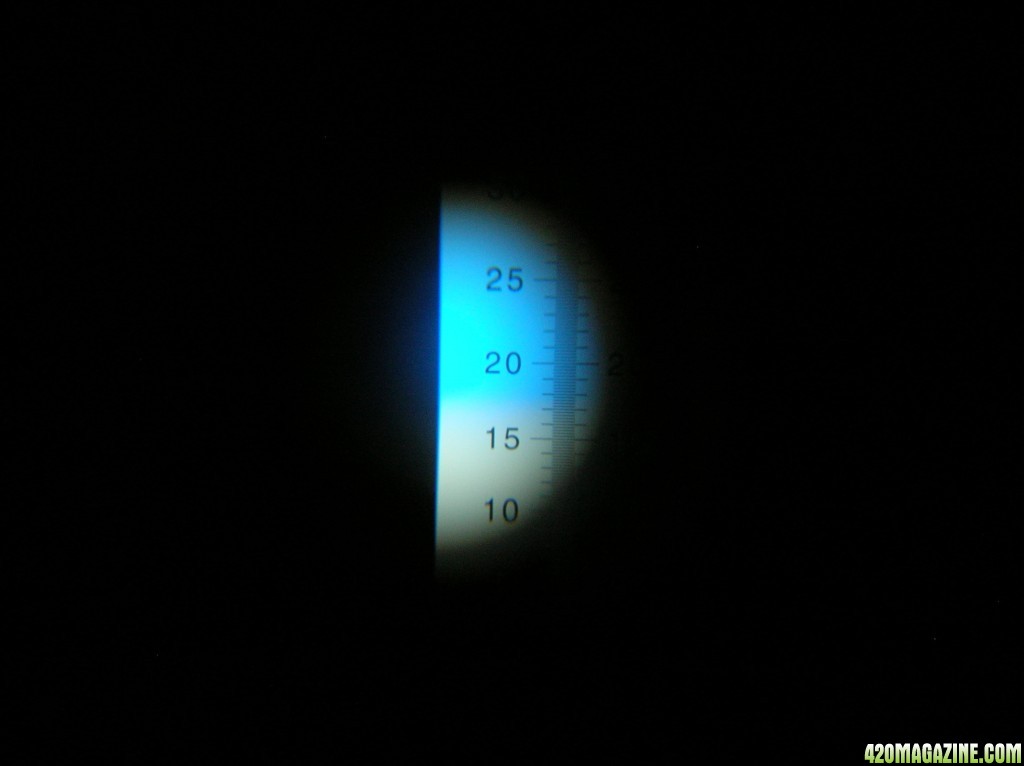
Reroll it and take another.

This is from my Carn2. She dropped a bit since last week but I'll take a 17/17 any day.
Yesterday I decided to take some pics while I tested Carn2. Here's what I start with - vicegrips, a couple of thick metal slugs, a refractometer, and a typical healthy 5 bladed leaf.
I start by tucking the pertiole against the leaf and rolling/twisting it together.
Tuck it again, twist some more ...
I put the wad between the slugs and squish it carefully around the disks without releasing any juice ...
I reroll it, squish it for real and let a drop touch the prism ...
Flip it closed and take a reading ...
Reroll it and take another.
This is from my Carn2. She dropped a bit since last week but I'll take a 17/17 any day.

As long as we're on this whole brix testing subject ...
Yesterday I decided to take some pics while I tested Carn2. Here's what I start with - vicegrips, a couple of thick metal slugs, a refractometer, and a typical healthy 5 bladed leaf.

I start by tucking the pertiole against the leaf and rolling/twisting it together.

Tuck it again, twist some more ...





I put the wad between the slugs and squish it carefully around the disks without releasing any juice ...

I reroll it, squish it for real and let a drop touch the prism ...


Flip it closed and take a reading ...

Reroll it and take another.

This is from my Carn2. She dropped a bit since last week but I'll take a 17/17 any day.
You should consider making a DIY How To For High Brix Readings Samples.
Do It Yourself
Nice post, Gray. You showed me the vicegrips and metal slugs method a while back. I've been using a stout c-clamp instead of the vicegrips and usually wad up three or four leaves. Same as you, I do an initial crush, reroll the wad, and then go for the final drop-producing crush. Nice reading on the Carnival! *Note to self, order some Carnival seeds*
Conradino23
Well-Known Member
You frequently refer to viniculturalists in brix discussions. Typically grape growers love a dry fall with lower soil moisture and RH which leads to a higher concentration of terpines in the stems, seeds and skins of the berries, as well as a higher sugar concentration (or more specifically higher sugar/organic acid ratios) in the fleshy interior i.e.; higher brix and lower overall weight yields. In theory high brix readings come from a combination of soil and atmospheric conditions.
It's not completely true. Different varieties will give best grapes only with perfect conditions they've been acclimatized to, and these rarely fit in the box of wet summer and dry fall. Certain regions produce best wines... with help of skilled enologists of course, cause grapes love their microclimates. Let's take pinot nero (pinot noir), one of premium varieties grown in Italy and in France. The best wines produced from pinot nero come from Trentino-Alto Adige (northwestern Italy), cause these grapes love temperature swings during the season. In Trentino it's either very hot or very cold, and that's what gives their pinot nero a real edge.
Another good example is one of the best northern Italian varieties: Nebbiolo, which you'll never be able to grow in California, cause this variety loves high humidity throughout the summer and early autumn with lowering temps in October. Grown in different climates Nebbiolo won't produce a good wine even with brix sky high.
Just my 5 cents.
Happy growung guys!
It's not completely true. Different varieties will give best grapes only with perfect conditions they've been acclimatized to, and these rarely fit in the box of wet summer and dry fall. Certain regions produce best wines... with help of skilled enologists of course, cause grapes love their microclimates. Let's take pinot nero (pinot noir), one of premium varieties grown in Italy and in France. The best wines produced from pinot nero come from Trentino-Alto Adige (northwestern Italy), cause these grapes love temperature swings during the season. In Trentino it's either very hot or very cold, and that's what gives their pinot nero a real edge.
Another good example is one of the best northern Italian varieties: Nebbiolo, which you'll never be able to grow in California, cause this variety loves high humidity throughout the summer and early autumn with lowering temps in October. Grown in different climates Nebbiolo won't produce a good wine even with brix sky high.
Just my 5 cents.
Happy growung guys!
FWIW, we do have nebbiolo here on the Central Coast. We have enough humidity in the evening and morning hours to make it work.
Environment is the single most important factor for success of growing ANYTHING, including grapes and of course the best plant in the known universe.
Flow buddy
New Member
Hey guys wondering if you could check out my crop, I'm from mass, and it's my first grow so any help would be great! Here's a link to my blog please help!First grow - Blogs - 420 Magazine ®
You are right, Conradino, that what I wrote is not entirely true. Rather, it is a generalization. Dry fall weather increases wine grape brix. High brix fruit does not necessarily equate to good wine. Too much sugar leads to residual sugar left behind when the alcohol from fermentation kills the yeast before it has consumed all the sugar - resulting in flabby fruit bombs (another generalization.) Wine is another topic altogether, and a complex one. I've been fortunate to have extensive contact with the wine folks over the years and have many good friends in the wine business. Interestingly while visiting a friend who has a small winery in the Santa Ynez valley the end of last month he popped open a bottle of Nebbiollo from a small winery in Paso Robles that was pretty decent; on par with most standard Nebbiolo d' Albas but falling far short of a first rate Barolo or Barbaresco.
This ain't the place to go all wine geek. I'm only wondering if the low RH where I grow is one of the things that drives the high brix readings I've been seeing from my cannabis.
This ain't the place to go all wine geek. I'm only wondering if the low RH where I grow is one of the things that drives the high brix readings I've been seeing from my cannabis.
You are right, Conradino, that what I wrote is not entirely true. Rather, it is a generalization. Dry fall weather increases wine grape brix. High brix fruit does not necessarily equate to good wine. Too much sugar leads to residual sugar left behind when the alcohol from fermentation kills the yeast before it has consumed all the sugar - resulting in flabby fruit bombs (another generalization.) Wine is another topic altogether, and a complex one. I've been fortunate to have extensive contact with the wine folks over the years and have many good friends in the wine business. Interestingly while visiting a friend who has a small winery in the Santa Ynez valley the end of last month he popped open a bottle of Nebbiollo from a small winery in Paso Robles that was pretty decent; on par with most standard Nebbiolo d' Albas but falling far short of a first rate Barolo or Barbaresco.
This ain't the place to go all wine geek. I'm only wondering if the low RH where I grow is one of the things that drives the high brix readings I've been seeing from my cannabis.
In Cannabis, low rH means the plant will use a great deal of potassium. To an extent, this will help us achieve high brix as excess K is perhaps the main limiting factor in soil that we deal with.
Bottom line: don't fix it if its not broke.
RE Nebbiollo: I know that winery you speak of! We've also got small lots of Tannut, Carignon and other varietals that aren't seen everywhere. It has to do with the diurnal temp swings that bring fog off the ocean in the evening hours.
- Thread starter
- #1,300
It's time for another update. 
The room is getting quiet and going to stay that way for awhile now. I'm down to four flowering plants for the next month or so. Carn2 will be chopped this week and replaced by Cotton Candy x Carnival. After that, the next harvest won't be for another month when Grapefruit Cut1 will be finished. I have a couple Utopia Haze seedlings going and I'll start a Blue Blood this week, but I'll do those in a new journal I think.
Carnival Cut2 is looking to be my best plant yet. I've been kinda pushing the limits of my soil and growing conditions, so it's nice to be able to hit a new high, so to speak. The sample I took was noticeably better, stronger, smoother than the Carnival I've been smoking from the original for the past several weeks. That sample came from a 18/19 brix plant. This week she reads 17/17. It would have been nice if it had stayed above 18, but it's reassuring to see it stay that high. I've only had two other plants above 16. And ... it occurs to me that the trichs I smoked have already been formed and won't be altered by a change in brix ...right? It's the ones that are being filled now that will have the 17 brix resin. Meanwhile, earlier trichs are degrading in the light and heat. I took another lower, finished bud and checked it good for ambers, and it runs about 10-15% on the mature stuff, very few clear, of course. Another 5-6 days should be good for it - still putting out some white hairs. I want to see how Carnival behaves when you run it long. So far, no issues. I did see one teensy undeveloped nanner that I didn't even bother plucking - wouldn't mind some seeds - so it may have a tendency to go unstable, but otherwise it looks fine. It'll get one more Energy feeding on Thursday, too, so that should help with the finish.
- so it may have a tendency to go unstable, but otherwise it looks fine. It'll get one more Energy feeding on Thursday, too, so that should help with the finish.
Carn2 - 134 days old - 62 days 12/12 - 55 days since pistils - brix 17/17






Grapefruit Cut1 will be next. It's already growing some nice trichs at just 4 weeks since the flip. It got a recharge and its first drench last week. It's small, but it looks pretty good so far.
GF1 - 134 days old - 28 days 12/12 - 14 days since pistils - brix 10/10





WW x Skunk#1 is a certified wild thang, all fluffy and hyper - she grew another 11 inches this week after doing 13 inches last week. She's already past my upper growth range so I'll have to move the light up and set everything else on risers. Bah. I'm guessing she'll go another 6 inches before she stalls and then creep up another couple while she grows her flowers. ... But there's a certain charm to her.
WWxSk#1 - 57 days old - 14 days 12/12 - 3 days since pistils - brix 11/12





Cut3 might be my best Carnival veg so far. I have a whole crap ton of tops on this one. The trick will be to anticipate the weak stems this time - find a way to support them better. If I can pull it off, this one could be a monster.
Carn3 - 78 days old - 7 days 12/12 - brix 10/11





I potted Cotton Candy x Carnival. This is an accidental pollination, so it's unstable. Do I see a lot of Power Plant in this pheno? Kinda squat and indica, unlike either parent. It'll be interesting if nothing else. This and the GF2 got heavily watered, so they're kinda limp.
CCC - 38 days old



Grapfruit Cut2. I'll fatten this one up good before I flip it - at least another couple weeks.
GF2 - 33 days old



I still have four healthy Carnival cuts, with several more cuts that I just dumped in cups of water over a week ago. A couple of them are growing their shoots - all glowing lime green and eager - odd to watch. They're even growing little brownish root nodes. One of these days, I'll pop 'em in soil and see what happens. How are your willow water cuts doing, Reg?



The room is getting quiet and going to stay that way for awhile now. I'm down to four flowering plants for the next month or so. Carn2 will be chopped this week and replaced by Cotton Candy x Carnival. After that, the next harvest won't be for another month when Grapefruit Cut1 will be finished. I have a couple Utopia Haze seedlings going and I'll start a Blue Blood this week, but I'll do those in a new journal I think.
Carnival Cut2 is looking to be my best plant yet. I've been kinda pushing the limits of my soil and growing conditions, so it's nice to be able to hit a new high, so to speak. The sample I took was noticeably better, stronger, smoother than the Carnival I've been smoking from the original for the past several weeks. That sample came from a 18/19 brix plant. This week she reads 17/17. It would have been nice if it had stayed above 18, but it's reassuring to see it stay that high. I've only had two other plants above 16. And ... it occurs to me that the trichs I smoked have already been formed and won't be altered by a change in brix ...right? It's the ones that are being filled now that will have the 17 brix resin. Meanwhile, earlier trichs are degrading in the light and heat. I took another lower, finished bud and checked it good for ambers, and it runs about 10-15% on the mature stuff, very few clear, of course. Another 5-6 days should be good for it - still putting out some white hairs. I want to see how Carnival behaves when you run it long. So far, no issues. I did see one teensy undeveloped nanner that I didn't even bother plucking - wouldn't mind some seeds
 - so it may have a tendency to go unstable, but otherwise it looks fine. It'll get one more Energy feeding on Thursday, too, so that should help with the finish.
- so it may have a tendency to go unstable, but otherwise it looks fine. It'll get one more Energy feeding on Thursday, too, so that should help with the finish.Carn2 - 134 days old - 62 days 12/12 - 55 days since pistils - brix 17/17
Grapefruit Cut1 will be next. It's already growing some nice trichs at just 4 weeks since the flip. It got a recharge and its first drench last week. It's small, but it looks pretty good so far.
GF1 - 134 days old - 28 days 12/12 - 14 days since pistils - brix 10/10
WW x Skunk#1 is a certified wild thang, all fluffy and hyper - she grew another 11 inches this week after doing 13 inches last week. She's already past my upper growth range so I'll have to move the light up and set everything else on risers. Bah. I'm guessing she'll go another 6 inches before she stalls and then creep up another couple while she grows her flowers. ... But there's a certain charm to her.

WWxSk#1 - 57 days old - 14 days 12/12 - 3 days since pistils - brix 11/12
Cut3 might be my best Carnival veg so far. I have a whole crap ton of tops on this one. The trick will be to anticipate the weak stems this time - find a way to support them better. If I can pull it off, this one could be a monster.

Carn3 - 78 days old - 7 days 12/12 - brix 10/11
I potted Cotton Candy x Carnival. This is an accidental pollination, so it's unstable. Do I see a lot of Power Plant in this pheno? Kinda squat and indica, unlike either parent. It'll be interesting if nothing else. This and the GF2 got heavily watered, so they're kinda limp.
CCC - 38 days old
Grapfruit Cut2. I'll fatten this one up good before I flip it - at least another couple weeks.
GF2 - 33 days old
I still have four healthy Carnival cuts, with several more cuts that I just dumped in cups of water over a week ago. A couple of them are growing their shoots - all glowing lime green and eager - odd to watch. They're even growing little brownish root nodes. One of these days, I'll pop 'em in soil and see what happens. How are your willow water cuts doing, Reg?




